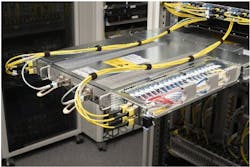Infinera High-Density Ethernet Aggregator Targets Cable Distributed Access Architectures
Infinera (NASDAQ:INFN) used this week’s SCTE Cable-Tec Expo in Atlanta to launch the High-Density Ethernet Aggregator (HDEA). The packet-optical 10-Gbps to 100-Gbps traffic aggregator aims to meet the demands of future Distributed Access Architectures (DAA) in cable operator networks.
Spurred by an explosion in headend space and power requirements, cable operators are moving toward DAA implementations that will see functions moved from these headends into remote nodes. As the evolution progresses, large-scale switching and aggregation will become necessary, said Infinera Director of Metro Marketing Jon Baldry in a conversation at the show. Infinera has significantly increased the port density of a standard 1RU Ethernet switching platform by moving the optical interfaces from the front panel to the two side panels. The change enables the HDEA packet platform to handle 40 SFPs on each side for a bidirectional total of 1.6 Tbps of traffic capacity. The current 10 Gigabit Ethernet ports will evolve to 25 Gigabit Ethernet in the future, says Baldry.
As the platform consumes essentially the same amount of power as a typical 40-port Ethernet switch, the double-density design effectively halves the amount of power per connection, Baldry pointed out. For ease of installation, Infinera will pre-stage the platform with all the necessary fiber connections. The packet-optical platform connects with a separate mux/demux box via MPO cabling. Infinera expects technicians will be able to get both platforms running in approximately 10 minutes, thanks in part to an enhancement to the Auto Lambda technology Infinera introduced at last year’s Expo. The zero-touch-provisioning technology enables optical transceivers at both ends of the connection to auto-tune to the appropriate transmission and reception wavelengths. Tuning capabilities on both ends of the connection represent the major change in Auto Lambda from last year and was made after cable operator input, Baldry said.
Baldry revealed the HDEA is available now and is currently in the hands of customers for evaluation. The new iteration of Auto-Lambda should be available in the first quarter of next year, he added. While cable operators represent the initial target market for the HDEA, Baldry speculated the platform also could find use in other applications where packet aggregation and transport are necessary, including 5G networks, data centers, and colocation facilities.
For related articles, visit the Network Design Topic Center.
For more information on high-speed transmission systems and suppliers, visit the Lightwave Buyer’s Guide.
About the Author
Stephen Hardy
Editorial Director and Associate Publisher
Stephen Hardy has covered fiber optics for more than 15 years, and communications and technology for more than 30 years. He is responsible for establishing and executing Lightwave's editorial strategy across its digital magazine, website, newsletters, research and other information products. He has won multiple awards for his writing.
Contact Stephen to discuss:
- Contributing editorial material to the Web site or digital magazine
- The direction of a digital magazine issue, staff-written article, or event
- Lightwave editorial attendance at industry events
- Arranging a visit to Lightwave's offices
- Coverage of announcements
- General questions of an editorial nature

